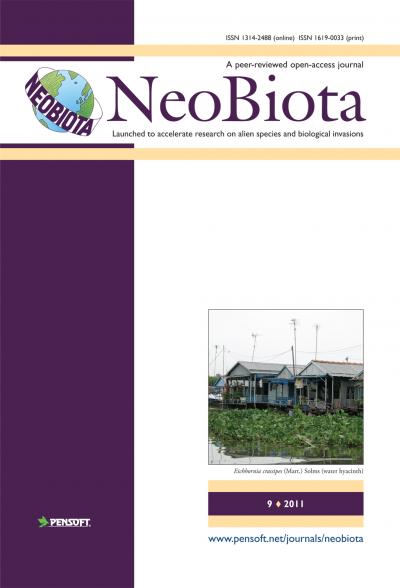Tree species preference and impact on native species community by the bark beetle Ips amitinus in a recently invaded region
IF 3
2区 环境科学与生态学
Q1 BIODIVERSITY CONSERVATION
引用次数: 1
Abstract
Non-native bark beetle species represent a major threat to forest ecosystems. The bark beetle Ips amitinus has recently expanded its range from Finland into northern Sweden. In the present study, we asked the following questions: (i) What is the distribution status in Sweden? (ii) Is there a difference in preference and reproductive success between Norway spruce and Scots pine? (iii) How common is the species after range expansion and does it influence the native community of bark- and wood-boring beetle species? We established the presence of I. amitinus and co-existence with the native community through checks of logging residues at 382 localities in northern Sweden. In addition, attack densities and reproductive success were compared between spruce and pine through investigating field material and by a no-choice rearing experiment. We found that I. amitinus is distributed over large parts of northern Sweden. Within its distribution area, it was found in 58% of all checked localities. It is one of the most common bark beetle species in logging residues and a higher proportion of Norway spruce objects compared to Scots pine were colonised. Attack density and reproductive success were higher in Norway spruce in field material and in the rearing experiment. There was no significant difference in the number of native bark- and wood-boring beetle taxa between localities where I. amitinus was present or absent.Tree新入侵地区树皮甲虫的物种偏好及其对本地物种群落的影响
外来树皮甲虫是森林生态系统的主要威胁。树皮甲虫Ips amitinus最近将其活动范围从芬兰扩展到瑞典北部。在本研究中,我们提出了以下问题:(i)瑞典的分布状况如何?挪威云杉和苏格兰松在偏好和繁殖成功率方面是否有差别?(iii)范围扩大后的物种有多普遍?是否会影响树皮和蛀木甲虫的本地群落?我们通过对瑞典北部382个地方的伐木残留物进行检查,确定了阿米蒂螨的存在并与当地群落共存。此外,通过实地资料调查和无选择饲养试验,比较了云杉和松木的攻击密度和繁殖成功率。我们发现I. amitinus分布在瑞典北部的大部分地区。在其分布区域内,在所有检查的地点中发现了58%。它是伐木残留物中最常见的树皮甲虫种类之一,与苏格兰松相比,挪威云杉物体的比例更高。田间资料和饲养试验中,挪威云杉的侵染密度和繁殖成功率较高。在有或无木蠹的地区,原生树皮和木材蠹类的数量没有显著差异。
本文章由计算机程序翻译,如有差异,请以英文原文为准。
求助全文
约1分钟内获得全文
求助全文
来源期刊

Neobiota
Agricultural and Biological Sciences-Ecology, Evolution, Behavior and Systematics
CiteScore
8.10
自引率
7.80%
发文量
0
审稿时长
6 weeks
期刊介绍:
NeoBiota is a peer-reviewed, open-access, rapid online journal launched to accelerate research on alien species and biological invasions: aquatic and terrestrial, animals, plants, fungi and micro-organisms.
The journal NeoBiota is a continuation of the former NEOBIOTA publication series; for volumes 1-8 see http://www.oekosys.tu-berlin.de/menue/neobiota
All articles are published immediately upon editorial approval. All published papers can be freely copied, downloaded, printed and distributed at no charge for the reader. Authors are thus encouraged to post the pdf files of published papers on their homepages or elsewhere to expedite distribution. There is no charge for color.
 求助内容:
求助内容: 应助结果提醒方式:
应助结果提醒方式:


